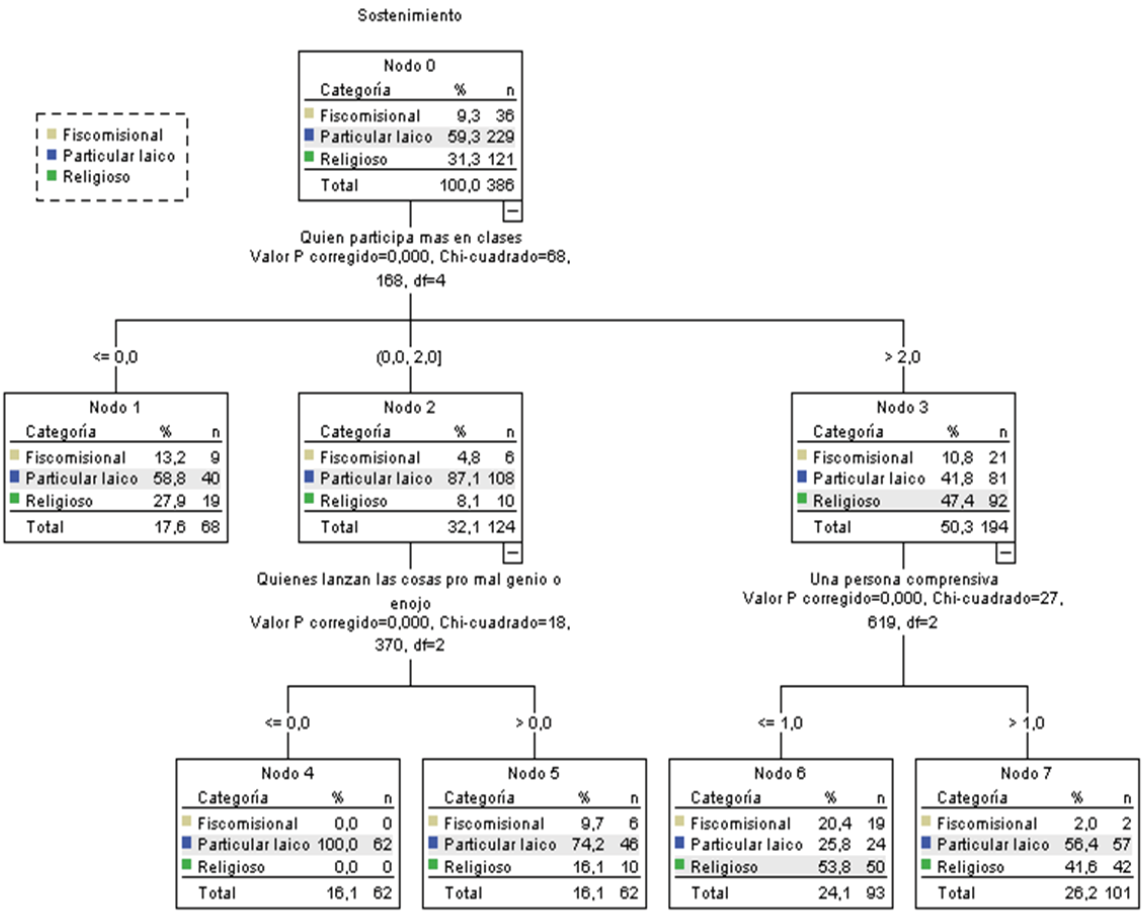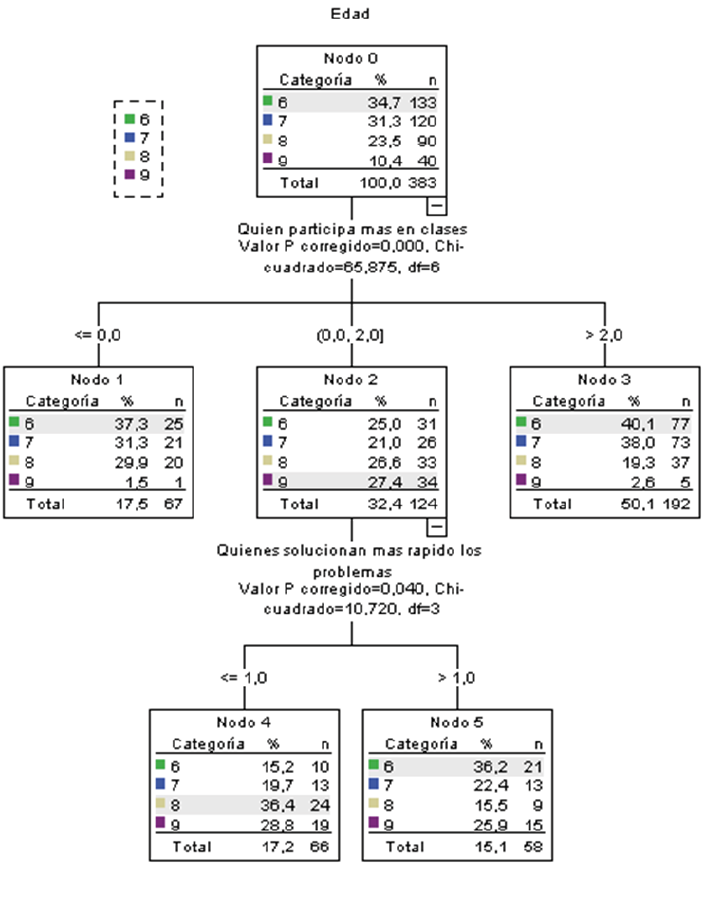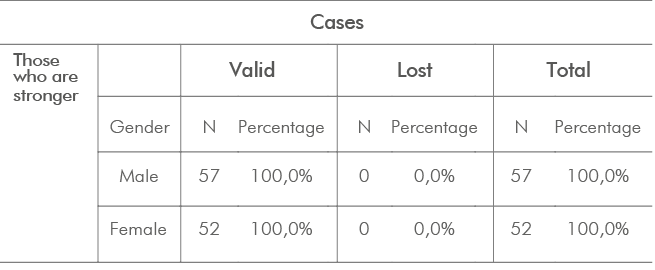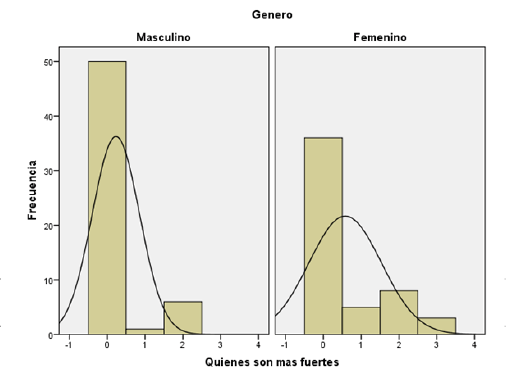DANILO VELASTEGUÍ (b)
CAROLINA E. SAN LUCAS(*a)
![]() ,
CRISTINA PÁEZ QUINDE (a)
,
CRISTINA PÁEZ QUINDE (a)
![]() ,
,
DANILO VELASTEGUÍ (b)
![]() ,
ELENA D. ROSERO MORALES(a)
,
ELENA D. ROSERO MORALES(a)
![]()
(a) Facultad de Ciencias Humanas y de la Educación,
Universidad Técnica de Ambato, 180104, Ambato-Ecuador
(b) Pontificia Universidad Católica del Ecuador
Sede Ambato, 180104, Ambato-Ecuador
*carolinaesanlucass@uta.edu.ec
RESUMEN
Esta investigación se basa en varios estudios de género que muestran la relevancia de su concepción en el desarrollo psicosocial del ser humano, reflejada en el comportamiento diario de convivencia dentro de la familia con otros contextos sociales. Cuando hablamos de igualdad de género significa tener las mismas condiciones y oportunidades para todos los seres humanos que responden a los derechos universales en su pleno desarrollo, en cuanto a representaciones mentales tenemos que identificar la simbólica de las formas en las que la realidad se produce sin ella y así,
dar sentido a todo lo que nos rodea organizando estructuras y partiendo del contexto social. El objetivo principal es relacionar teóricamente cómo las representaciones mentales de género están influenciadas por la socioconstrucción cognitiva justificando la etapa de latencia como la edad ideal para romper los estereotipos mentales que conforman la conciencia crítica del individuo y permitirnos imaginar nuevos escenarios sociales. sin la obligación de proyectar los heredados culturalmente.
Recibido: 2021-04-18
Aceptado: 2021-05-18
La metodología de esta investigación es experimental y utiliza dos instrumentos de investigación presentados al Estadístico Alfa de Cronbach con un nivel de confiabilidad de 0.799 para niños y niñas y 0.718 para docentes y padres de segundo a cuarto nivel a través de una metodología integrada que busca modificar el género. modelos mentales dentro del entorno del niño en la escuela. Así, el estudio se basa en un modelo predictivo, es decir, la aplicación del árbol de decisiones para la construcción de un modelo aplicable al contexto de los estereotipos de género, para prevenir la violencia de género en el ámbito escolar.
Palabras claves: Representaciones mentales, construcción socio-cognitiva, género, algoritmo de árboles de decisión, modelos predictivos.
ABSTRACT
This research is based on several gender studies that show the relevance of its conception in the psychosocial development of the human being, reflected in the daily behavior of coexistence within the family with other social contexts. When we talk about gender equality means having the same conditions and opportunities for all human beings who respond to universal rights in their full development, in terms of mental representations we have to identify the symbolic of the forms in which reality is produced without it and thus give meaning to everything around us by organizing structures and starting from the social context.
The main objective is to theoretically relate how mental representations of gender are influenced by cognitive sociobuilding by justifying the latency stage as the ideal age to break the mental stereotypes that make up the critical awareness of the individual and allow us to imagine new social scenarios without the obligation to project those culturally inherited. The methodology of this research is experimental and uses two research instruments submitted to the Statistician Alfa de Cronbach with a reliability level of 0.799 for boys and girls and 0.718 for teachers and parents from second to the fourth level through an integrated methodology that seeks to modify gender mental models within the child’s environment in school. Thus, the study is based on a predictive model, i.e. the application of the decision tree for the construction of a model applicable to the context of gender stereotypes, to prevent gender-based violence in school settings.
Keywords: Mental Representations, Socio-cognitive Constructions, Gender, Decision Tree Algorithm, Predictive Models.
DESCRIPTION OF THE SOCIAL PROBLEM
This research allows the exploration from a gender perspective through mental representations in reference to gender equality at school environments through a test that permits the identification and analysis of behaviors since phrases, feelings, emotions and activities that are developed on a daily basis in the school environment.
Additionally, several aspects can be defined that are rooted directly with the mental representations such as culture, setting and time to which they belong, and which contradict the intention of social justice.
SYNTHESIS AND PRACTICAL APPLICATIONS
INTRODUCTION
The school has an important role in the stage that the child goes through, and it is studied in the present article. The challenge for the educational institutions is big because it implies that this one under the guideline of a macro curriculum elaborates a gradual and deep breakdown of the stereotypes, social, and cultural representations clearly patriarchal.
A breakdown that can be developed through the discussion and a serious, conscious and critical approach to these topics, so that the new equality concepts become familiar and introduced in the mental representations of boys and girls, and are shown in the daily community culture of the school and can gradually transform the reality that lives towards more just societies (Winfield, Jiménez, & Topete, 2017).
The school methodology attempts to facilitate the creation of cognitive ¨conflicts¨ that allows students to face their ideas, in an honest and respectful dialogue, regarding their daily experiences and available information in the bibliography and, in an especial manner, within the painful society issues and reflect about the alternative forms in society, the gender equality is very connected to the social justice and dialogue (Kourtis, Wozniak, Sebanz, & Knoblich, 2019).
Another way to internalize traditional gender stereotypes is the school situations and cyberbullying, violence or bullyng, which reduce every day the effective base of the boy or girl, who has entered into the relationship with his peers through the school space. The family, as protector figure cannot, anymore reach these environments and leaves this to the school, which in occasions lacks knowledge of what should be done, so the infants are left alone with the concerns and difficulties of the stage that they have to pass: the latency stage (Zabarain, Quintero, & Russo De Vivo, 2015) .
This investigation was developed with children at school environments, with the aim to recognize the perceptions that they have, also, to locate the stablished differences between female and male within the intersubjective logic both in social groups and in the development of their environment, the transmission of a model that allows identifying values that determine and maintain the hegemonic and asymmetric order in power which is generalized through the history (Liu, Li, Shen, Cao, & Mao, 2017).
In addition, it is relevant to consider the study importance regarding the mental representations of gender in which values, beliefs, and pre-established ideological assumptions can be made visible; based on the differentiated ascription of characteristics and, therefore, the social roles that place men and women in different positions since childhood and even more in school environments (Nagalla, Pothuganti, & Pawar, 2017).
By having a large amount of data information regarding gender stereotypes, the development of decision trees (Waseem-Ahmad, reyolds, & Rezgui, 2018) and the prediction of information based on what is obtained are taken into account, that is, for this investigation techniques were taken into account and methods for learning models, taking into account that a decision tree is a set of conditions that are organized by a hierarchical structure (Raina V. Voss MD, 2021), so that the decision made can be determined following the conditions that are being met from (Subasi, Ahmed, & Alickovic, 2018) at the root of the tree to some of its leaves, decision trees are most commonly used in medical, commercial, legal, mathematical, logical, educational and psychological procedures, seeking the possible options from a certain condition and determining the most appropriate action to take into account in the investigation (Nowak, 2017).
A mental representation of gender in childhood is all the accumulation of knowledge that a person possesses and is represented in her/his mind in a specific form of knowledge allowing her/him to express herself/himself before others in a particular behavior and communication; therefore, is the knowledge by which people can interpret the reality in which they develop themselves by using, as referents, their ethical and moral values, social roles, needs, and other socio-cultural aspects (Winfield, Jiménez, & Topete, 2017).
(Kourtis, Wozniak, Sebanz, & Knoblich, 2019) quoted Senge (2004) who says: ¨Mental models are images, assumptions, and stories we carry in our minds about ourselves, others, institutions and all aspects of the world” (Kourtis, Wozniak, Sebanz, & Knoblich, 2019); in other words, such cognitive representations determine what and how reality looks and models the acts of the observing subject; these can be changed through successive transformations towards new mental models that allow reinterpreting the world. The same happens when talking about gender equality, from mental representations, with the difference that it also affects behavior (Winfield, Jiménez, & Topete, 2017). The concept of gender is found in the symbolic imaginary of every human being and society in general since it marks male-female relationships as a connection not only logical and natural but also unquestionable of the daily task that reflects and represents it without much difficulty (Cares & Herraiz, 2017).
Biological-bodily differences are symbolized and constitute a foundation for establishing social relationships, above all, for build power. The starting point is what it means to be a man and woman, and then attributing spaces, resources and destiny to them, is to ask about the meanings of being a man and a woman, as well as the (dis) advantages of being one in the private-public spheres.
The construction process of mental representations is the symbolization of a human being characteristic, there daily and so common symbols that it is not difficult to interpret them since throughout history they have been created and given their interpretation that is almost universal in character, furthermore, in this symbolic reality we all represent something in relation to others.
The difficulty is within the ability that people have to interpret the symbols or make them explain through them (Cares & Herraiz, 2017), these mental representations are expressed in three forms to be coded: auditory, visual, tactile. (Greca & Moreira, 2016), paraphrasing to Johnson-Laird (1990) note that the key to understanding mental representations lies in the existence of a “working model” in the mind of the interpreter. The ability to be explained an idea or situation creates a “manual”, a guide that may not serve another, everything depends on the ability, knowledge, and skills to understand.
The construction of mental representations goes through four steps that people face before responding to any situation:
Within the stage of latency, it becomes real in a concrete context of the person’s life, specifically in the stage of bio-psycho-social development that approximately goes between six and eleven years old: it is the latency stage. In this period the manifestations of infantile sexuality decline (Freud, 1967), there is a decrease in activities related to eroticism and the feelings of shame, disgust, moral and aesthetic aspirations appear.
Gender in school can appear and trace multiple paths; it encompasses research, teaching or intervention. Gender does presence in the manner of a kind of “epistemological wild card” (Fernández, 2020) that strengthens male dominance, such as deconstructing values patriarchal. Gender is the norm, in turn, it is a perspective for reconfigure that rule.
The complex thing about the relationship between gender and school is that it feels its own bases in the implicit, in what is not conscious and that is part of the existing systemic violence in schools (Kerr, Torre, Giguère, Lupien, & Juster, 2021). This is what causes damage without direct responsibility. Where knowledge incorporates the values of the dominant society and causes failure to be assumed by the weakest.
Great importance is given to integration with peers and belonging to a group of friends. The learning of skills is strengthened, the awareness of responsibilities, reflection, desire to learn, recreation, sports, etc. grow. (García-Piña, 2016).
This stage is essential for the psycho-affective development of human beings because it establishes important aspects of the psychic formation of the Super-Ego (moral conscience); the symbolic government of reality is underlined and the path is prepared for independence and adaptation to later reality within adolescence and adulthood (Zabarain, Quintero, & Russo De Vivo, 2015). The parent’s dependence starts to decline and they are replaced by a sense of self-value derived from the achievements, social and objective approval (Zaidi & Fordham, 2021).
The father figures, at first, are projected in non-real characters, with magical and omnipotent powers. They are the superheroes (Spiderman, Power Ranger, etc.) and then it will be changed by real figures, although still idealized, like sports idols, models, or artists (Sneiderman, et al., 2017).
The social development during the latency stage is very important, even becoming determinant, the experiences lived, in a future for the consolidation or not of the self and the formation of the identity (Zabarain, Quintero, & Russo De Vivo, 2015).
Social learning will be acquired in several ways:
Direct experience. The child builds its own knowledge, acquires it, changes it, improves skills, behaviors, and values from its own experience or thanks to what others, of influence to him, tell him to perform. The experience will depend on the consequences of the behavior he performs, that is, to be accepted or rejected.
MATERIALS AND METHODS
As a starting point, the samples taken for developing the comprehensive methodology of gender in school environments have the following characteristics:
236 among boys and girls from schools in rural areas of Tungurahua province.
Private school environments.
The research is developed under an essentially by parts investigation approach where the review, analysis and theoretical interpretation of the variables under study are: mental representations of gender and socio-cognitive construction located in a context of time such as the latency stage is (Barreiro-Gen, Lozano, Temel, & Carpenter, 2021).
The research-based on the hermeneutic method and an emerging open coding design has allowed:
Accurate review of bibliographic information on the subject,
Qualitative categorization of variables,
Understanding and answer to the research question of how mental representations of gender are influenced by sociocognitive constructions in the latency stage,
Approach to future research that contributes to gender studies in childhood.
The type of research is entirely experimental, the application of a validated test was developed in the educational units through a pretest and a posttest, which allowed developing an experiment “application of the comprehensive methodology”, the experimentation process consisted basically of adapting the boys and girls to stereotypes that commonly consider the opposite gender, both in emotions, activities, processes, promoting with this the development of new proposals for acceptance, equity, and common work.
From the results obtained, it is concluded that gender differences are manifested at an early age through sociodramatic play, thus rehearsing children, and future behaviors.
Within the quantitative approach of this research, a decision tree was developed, through which you can predict the correct form of decisions that were made for the application of the Comprehensive Methodology of prevention to gender violence in these educational environments, resulting in from the decision tree the following results; as shown in figure 1.
According to the institutional support, it can be identified that the students with the largest population are in Secular Private educational institutions with 59.3% representing 229 children, for the measurement of gender violence, question 22 is taken.
“Who participates most in class?” Taking a decision that girls perform this activity with 87.1% representing 108 girls and at the same time another question of gender violence is considered in this case number 17. “Who throws things out of bad temper or anger?” For this decision, it is considered that children do more, obtaining a tendency in men.
The best decision that can be taken for an intervention of the Comprehensive Methodology of prevention of gender violence in educational environments of the Province of Tungurahua, in this case, is to educational units of Secular Particular support, in the field of violence of gender according to the participation in class to girls and for the actions to be carried out to those who throw things out of bad temper to boys.
In Figure 2, it can be identified that according to age, the surveyed children were from 6 years old, representing 34.7%, taking the root of the tree, the following leaves are obtained:
In the field of gender violence, question 22 “Who participates most in class?” the most relevant items in the decision with a chi-square of 65,875, the 9-year-old girls are the ones who participate most in class, and at the same time taking question 17 “Who solve the problems faster?” it can be evidenced that the 6-year-old girls who represent 36.2% solve the problems faster, and on the part of the 8-year-old boys with 36.4% they claim that they solve the problems faster.
Figure 1
Decision Tree

Figure 2
Age and gender violence

Concluding with the fact that if there is a difference in age in issues of gender violence; that is, from 7-9 years of age, it is the ideal age to cause reflection on gender issues, which coincides with the psychological theories that children are defining their gender role by what they observe or live-in ages older than 6 years.
RESULTS
In order to establish the relationship that exists between the mental representations of gender and the school environments before and after the intervention, qualitative data was analyzed, which at the same time allowed us to identify the correct hypothesis of our research, as shown in Table 1:
Table 1
Summary Case Processing

It can be identified by the Mann-Whitney U test for independent samples that the null hypothesis is rejected, which mentions that the comprehensive methodology application does not contribute to the mental representations of gender in school environments, finally by identifying the value of significance, the same that is less than 0.05; the alternative hypothesis is accepted table 2:
Table 2
Hypothesis test summary

The incorporation of gender in the educational programs of the Schools has not been simple, nor conflict-free. In Ecuador, it has its own origins in community projects, attached to popular and liberating education. It is the result of showing it as an element of the school culture, in particular, to understand how the school works in the construction of gender identities. The other force that pushes to insert it comes from the pressure of organized civil society, at the same time, in which new laws emerge, for example, that seek to promote gender equality, programs with public resources arise within the national educational system.
The existence of a study content or a cross-sectional approach on gender in schools in Ecuador is a substantial advance. Its origins are undoubtedly in the struggles led by feminist and sexual diversity movements. However, the androcentrism in schools is so strong that it manages to dispel the conceptual richness and limit them to a basic level.
This is demonstrated by the reports, above all, prepared from the Universities when seeking to answer how to evaluate the perspective gender in those instances. In the case of basic education, the little information regarding the different programs that are used in these schools by the Ministry of Public Education is the one, which stands out.
What exists, in the best of cases, is based on some aspects like: the numerical and the stage of training, the number of children who attended, the content that was delivered, and so on. With regard to Normal education, the panorama is similar, there is little information about the results of incorporating gender and there is a duty in this regard for this specific level.
Asymptotic significances are shown. The level of significance is 0.5. for the data distribution of the question: “who is stronger?“ has been considered, and in this way, we identify the data distribution through the normality curve at the moment of choosing the response options, as shown in Figure 3:
Table 3
Distribution

As it can be seen in figure 3, boys have a more symmetric normality curve; that is, the data have a normal distribution; in contrast to the girls who in the normality curve could be identified asymmetry to the left, considering that there is a more dispersed distribution in the choice of response options.
DISCUSSION
Gender education is a sensitive issue due to its conception and social performance; however, it is during the latency stage where social signals are coded regarding the observed, lived and acted from the impact of experiences, education and social coexistence, adapting and expressing cognitive and behavioral responses for the necessary moment, with reactions to the gender exposed and itself and cultural continuity or schematic breakdown of conducts around gender will depend on it.
Boys and girls in permanent interaction access to a society’s reading that allows them to collect information where, most of the time, a summary of cultural experiences related to gender is transmitted consciously and unconsciously. These readings are the product of stereotypes marked by culture and inherited from generation to generation with diversity of forms, but with the same content, thus influencing the construction of mental representations.
CONCLUSIONS
Cognitive construction coupled with a social reading of mental representations and conceptions around gender lead people into two options: either a) a social transformation according to the approach in which a society is developed, based on state policies that comprehensively address a stereotyped conceptual rupture, or
b) the continuity of an ideology by custom and cultural heritage; this second option would require a process of gender stereotypes rupture where all social actors from their different action levels become aware of and decide on structural changes in society regarding gender issues.
The constructed mental representations of gender give meaning and responses to expression needs within a specific context, generating codifications that recognize the same and that others can see and understand the information, which is transmitted orally, written, and gesturally.
ACKNOWLEDGMENTS
We would like to begin by expressing our gratitude to the Technical University of Ambato; to the Directorate of Research and Development (DIDE), for allowing us to develop our research project entitled Integral Methodology of gender forecasting in school environments of the Province of Tungurahua, code FCHE-14.
BIBLIOGRAPHIC REFERENCES
Barreiro-Gen, M., Lozano, R., Temel, M., & Carpenter, A. (2021). Gender equality for sustainability in ports: Developing a framework. Marine Policy, 131, 104593. doi:https://doi. org/10.1016/j.marpol.2021.104593
Cares, C., & Herraiz, F. (2017). Arte, género y discurso: Representaciones sociales en el Chile reciente. Retrieved from Dipòsit Digital de la Universitat de Barcelona: http:// hdl.handle.net/2445/109605
Fernández, A. B. (2020). Gender dysphoria/gender incongruity: Transition and discontinuation, persistence and desistance. Endocrinología, Diabetes y Nutrición (English ed.), 67(9), 559-561. doi:https://doi.org/10.1016/j. endien.2020.03.006
Freud, S. (1967). Una teoría sexual. En Obras Completas (Vol. I). Madrid, España: Biblioteca Nueva.
García-Piña, C. (2016, Enero - febrero). Sexualidad infantil: información para orientar la práctica clínica. Acta Pediátrica de México, 37(1), 43-53. Retrieved from http://www.scielo.org.mx/scielo.php?pid=S0186- 23912016000100047&script=sci_abstract&tlng=en
Greca, I., & Moreira, M. (2016). Un estudio piloto sobre representaciones mentales, imágenes, proposiciones y modelos mentales respecto al concepto de campo electromagnético en alumnos de física general, estudiantes de postgrado y físicos profesionales. Revista Investigações em Ensino de Ciências (IENCI), VI(1), 95-108. Retrieved from https://www.if.ufrgs.br/cref/ojs/index.php/ienci/article/ view/648/439
Herbst-Debby, A., Endeweld, M., & Kaplan, A. (2021). Differentiated routes to vulnerability: Marital status, children, gender and poverty. Advances in Life Course Research, 15, 100418. doi:https://doi.org/10.1016/j.alcr.2021.100418
Kerr, P., Torre, M. B., Giguère, C.-É., Lupien, S. J., & Juster, R.-P. (2021). Occupational gender roles in relation to workplace stress, allostatic load, and mental health of psychiatric hospital workers. Journal of Psychosomatic Research, 142, 110352. doi:https://doi.org/10.1016/j. jpsychores.2020.110352
Kourtis, D., Wozniak, M., Sebanz, N., & Knoblich, G. (2019). Evidence for we-representations during joint action planning. Neuropsychologia, 18(1), 73-83. Retrieved from http://www. revistaadbia.com.ar/ojs/index.php/adbia/article/view/ 366
Liu, X., Li, B., Shen, D., Cao, J., & Mao, B. (2017). Analysis of Grain Storage Loss Based on Decision Tree Algorithm. Procedia Computer Science, 122, 130-137. doi:https://doi. org/10.1016/j.procs.2017.11.351
Nagalla, R., Pothuganti, P., & Pawar, D. (2017). Analyzing Gap Acceptance Behavior at Unsignalized Intersections Using Support Vector Machines, Decision Tree and Random Forests. Procedia Computer Science, 474 - 481. doi:https:// doi.org/10.1016/j.procs.2017.05.312
Nowak, M. (2017). Defining Project Approach using Decision Tree and Quasi-hierarchical Multiple Criteria Method. Procedia engineering, 791-799.
Raina V. Voss MD, M. L. (2021). Supporting the Health of Transgender and Gender-Diverse Youth in Primary Care Settings. Primary Care: Clinics in Office Practice, 48(2), 259-270. doi:https://doi.org/10.1016/j. pop.2021.02.003
Roncero, D., Andreu, J., & Peña, M. (2016). Procesos cognitivos distorcionados en la conducta agresiva y antisocial en adolescentes. Anuario de Psicología Jurídica, 26(1), 88-101. Retrieved from https://www.sciencedirect.com/science/article/ pii/S1133074016300058?via%3Dihub
Sneiderman, S., Salvay, L., D’Acunti, M., Ghidella, M., Martino, F., Sivori, M., & colaboradores7. (2017). Exploración de la subjetividad y mecanismos de defensa en niños latentes mediante la interpretación del Cuestionario Desiderativo. Subjetividad y Procesos cognitivos, 21(1), 146-168. Retrieved from http://www.scielo.org.ar/scielo.php?pid=S1852- 73102017000100007&script=sci_arttext&tlng=en
Subasi, A., Ahmed, A., & Alickovic, E. (2018). Effect of Flash Stimulation for Migraine Detection Using Decision Tree Classifiers. Procedia Computer Science, 223-229.
Waseem-Ahmad, M., reyolds, J., & Rezgui, Y. (2018). Predictive modelling for solar thermal energy systems: A comparison of support vector regression, random forest, extra trees and regression trees. ournal of Cleaner Production, 810-821.
Winfield, A., Jiménez, Y., & Topete, C. (2017). Representaciones mentales y sociales en la equidad de Género. Revista de Estudios de Género. La ventana, 7(45). Retrieved from http:// www.redalyc.org/jatsRepo/884/88450033008/ index.html
Zabarain, S., Quintero, L., & Russo De Vivo, A. (2015, junio). Logros del yo durante el desarrollo psicoafectivo en la etapa de latencia. Revista Psicoespacios, 9(14), 129-160. Retrieved from http://revistas.iue.edu.co/index.php/Psicoespacios
Zaidi, R. Z., & Fordham, M. (2021). The missing half of the Sendai framework: Gender and women in the implementation of global disaster risk reduction policy. Progress in Disaster Science, 10, 100170. doi:https://doi.org/10.1016/j. pdisas.2021.100170
BIOGRAFÍA DE LOS AUTORES
 Carolina Elizabeth San Lucas Solórzano
Carolina Elizabeth San Lucas Solórzano
Magister en Gerencia y Mediación de Centros Educativos Infantiles, Doctora en Ciencias de la Educación Mención Gerencia Educativa, Licenciada en Ciencias de la Educación en la Especialidad de Educación Parvularia, Docente Investigadora de la Universidad Técnica de Ambato, Docente de Posgrado en varias Universidades del centro del país, Coordinadora de la Carrera de Educación Parvularia, Directora del Centro de Desarrollo Infantil de la Universidad Técnica de Ambato, Coordinadora de Prekinder de la Escuela La Providencia, Asesora pedagógica y capacitadora a docentes de diversos niveles educativos, Formadora de Docentes Universitarios, Investigadora en proyectos de: Prevención a la violencia de género en ambientes educativos escolarizados, Modelo De Pedagogía Social Comunitaria En El Proceso De Ejecución Penal De Los Centros De Rehabilitación Del Ecuador, Escritora de artículos científicos y Ponente con resultados de investigaciones en varios eventos académicos y científicos.
 Elena Del Rocío Rosero Morales
Elena Del Rocío Rosero Morales
Psicóloga Educativa y Orientadora Vocacional, Magister en Psicología Educativa conferido por la Universidad
Técnica de Ambato-Ecuador. Docente desde el
año 2010 en la Universidad Técnica de Ambato, en
la Facultad de Ciencias Humanas y de la Educación.
Docente de Posgrados en la UTA, PUCESA, UTI.
Ha Publicado artículos científicos indexados en: Latindex, Scopus, ISI Web. Escritora de varios capítulos
de libro publicados con revisores de pares externos y
con registro ISBN. Profesora de maestrías a nivel nacional, en módulos de Práctica y Acción Social, Proyecto
Integrador. Profesora del Curso de Actualización de Conocimientos organizado por Posgrados de
la UTA. Ha participado en la dirección y revisión de
tesis de grado y posgrado en la UTA, PUCESA, UTI.
Coordinador Principal de proyectos de investigación
financiados por la Universidad Técnica de Ambato.
Líneas de investigación: Necesidades Educativas
Especiales, Problemas de Aprendizaje, Violencia de
Género a nivel de escolaridad, psicología del desarrollo, adaptaciones curriculares, inclusión escolar,
procesos educativos, procesos de lectoescritura, procesos de enseñanza y aprendizaje.
 Marco Danilo Velástegui Carrasco
Marco Danilo Velástegui Carrasco
Magister en Ciencias de la Educación de la Pontificia Universidad Católica del Ecuador, Licenciado en Ciencias de la Educación en la especialidad de: Psicología Infantil y Educador Parvulario en la Universidad Nacional de Loja, Profesor en Ciencias de la Educación en la especialidad de Psicología Infantil y Educación Parvularia en la Universidad Nacional de Loja, Licenciado en Teología de la Pontificia Universidad Católica del Ecuador. Docente de Posgrado, asignatura de Ética en la Pontificia Universidad Católica Sede Ambato, Asistente del Departamento de Pastoral de la PUCESA. Director - responsable de la Misión Católica de Lengua Española Kloten-Winterthur en cantón Zurich (Suiza), Docente de las asignaturas de Filosofía y de Religión en la Unidad Educativa “La Inmaculada” de Ambato para Educación Básica, Media y Superior. Profesor de Religión en el Colegio Diocesano “San Pío X” de Ambato. Director del Departamento de Psicología del Centro Educativo “Huellitas School” en la ciudad de Ambato, Formador de valores cristianos a niños y niñas en los cantones de Tisaleo y Patate, Gerente del proyecto “Creciendo con Nuestros Niños” del FODI (Fondo de Desarrollo Infantil) realizado por la Fundación “Manos Unidas – Centro de Recuperación Integral”. Coordinador Técnico Comunitario en el proyecto “Creciendo con Nuestros Niños” del FODI (Fondo de Desarrollo Infantil) realizado por la Fundación “Manos Unidas –Centro de Recuperación Integral”.
 María Cristina Páez Quinde
María Cristina Páez Quinde
Ingeniera en Sistemas y Computación,
Magister en Tecnologías para la gestión y
práctica docente de la PUCESA, docente
investigadora de la Universidad Técnica de
Ambato – Faculta de Ciencias Humanas
y de la Educación, Docente investigadora
avalada por la SENESCYT, Coordinadora
Principal y Subrogante de proyectos de investigación; Subdirectora e integrante de
los grupos de investigación Research in
Language and Education y Marketing C.S.
autora y coautora de 20 artículos indexados en SCOPUS y revistas con factor de
impacto. Ponente y revisora de artículos
indexados en Springer Revista Technology,
Knowledge and Learning.
Docente de TIC, Investigación y Lectura y
Escritura de Textos Académicos de la Carrera de Educación Básica; Creadora de
proyectos de Investigación para la Facultad
de Ciencias Humanas y de la Educación.
Líneas de investigación: Tecnologías de la
Información y Comunciación y Educación